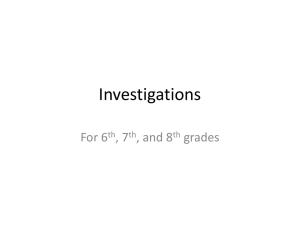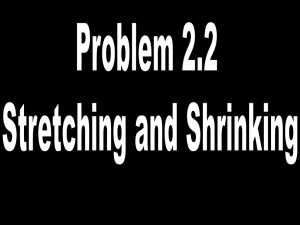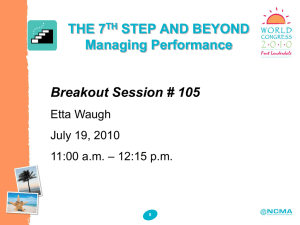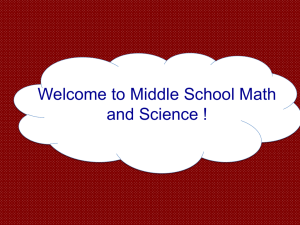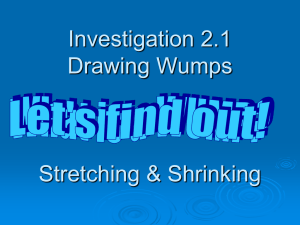Stretching and Shrinking Number Two Similar Figures
advertisement
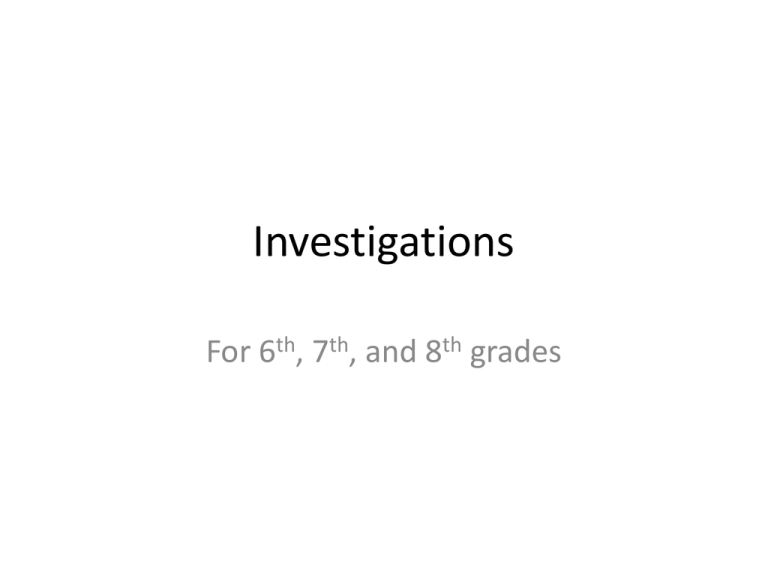
Investigations For 6th, 7th, and 8th grades Project commitment • D level: part one of investigation and do two “Connections” problems completed with all criteria (strategy shown how to solve the problem and picture models/manipulative models representing the problem and answer) Up to 11 points • As a class choose the two problems, so we can compare strategies and answers. Project commitment • C level: D level plus part two of investigation and do four “Connections” problems completed with all criteria Up to 13 points • As a class choose two more Connection problems to add to the two we already chose, so we can compare strategies and answers. • You and team members are creating math presentations to share strategies and solutions for each section. We have 2-3 weeks per unit. See rubric for how I will assess your project work. Attention: as we move through investigations, you must have notes complete for each section before being allowed to move on to the next section in the investigation. Project commitment • B level: C level plus part three of investigation, two problems from “Applications” and four “Connections” problems completed with all criteria Up to 15 points (Group chooses the two Application problems.) • A level: B level plus part four of investigation (if available), two problems from “Applications” , four problems from “Connections”, and two problems from “Extensions” completed with all criteria Up to 17 points (Independent choice for Extension problems) Project commitment • Sign up for what level you plan to go for as we begin investigation. • You are also expected to complete a word wall project for each investigation unit. Comparing and Scaling is 6th grade. Stretching and Shrinking is 7th grade. Thinking with Mathematical Models is 8th grade. Label your word wall on the back with the appropriate unit that your word belongs to with your S.A.N.D. 7th grade Did you know…? • Ever thought of being a computer programmer? • http://money.usnews.com/car eers/best-jobs/computerprogrammer #9 in U.S. News Best Jobs 2012 Overall Score: 6.8 Number of Jobs: 43,700 Median Salary: $71,380 Unemployment Rate: 7.9% Job Satisfaction: MEDIUM Investigation 2 Opener 7th grade Launch 2.1: “Drawing Wumps” • Goals: Use algebraic rules to produce similar figures on a coordinate grid. Focus student attention on both lengths and angles as criteria for similarity. Contrast similar figures with non-similar figures. Four in a Row 7th grade Launch 2.1: “Drawing Wumps” • How many of you know how to play tic-tac-toe? • How many do you need in a row to win? • Today, we will play a different game of tic-tac-toe. You will need four in a row to win. • We’ll play the left side of the class against the right side of the class. The left side can go first and tell me the coordinates. Four in a Row 7th grade: Four in a Row Coordinates must be equal to or less than the absolute value of 4. 7th grade Continue with 2.1 Launch • Supposed to have video of the Mug Wumps… • http://teachingtechie.typepad.com/learning/2010/04/th e-wumps-add-new-family-membersdid-you-ever-thinksimilarity-was-this-much-fun-in-math-class.html • Explore questions A-C. • http://www.geogebratube.o rg/student/m22093 …. 7th grade Continue with 2.1 Launch • The points for Zug are found from the points for Mug. The rule is (2x,2y). What do you think this rule tells us to do to a Mug point to get a Zug point? • What do the other rules tell you to do for Lug, Bug, and Glug? Explore Go through your table and compute the new value of the x and y for each point. Remember that you are always starting with Mug’s x- and ycoordinates. Then locate the points and connect them in sets as you did for Mug. 7th grade 2.1 Summarize Students should be prepared to share neatly formed Wumps under the document camera. (We should share this with the 8th graders to cover some concepts that we may have missed last year.) … • How would you describe to a friend the growth of the figures that you drew? • Which figures seem to belong to the Wump family and which do not? • Are Lug and Glug related? Did they grow into the same shape? 7th grade 2.1 Summarize In earlier math units in CMP, we learned that both angles and the lengths of edges help determine the shape of a figure. How do the corresponding angles of the five Wumps compare? … 7th grade 2.1 Summarize Now let’s look at the corresponding lengths for the five figures. Are the lengths related? Are some of them related and others not? How do the lengths in similar Wumps compare? Hint: a tool we can use is our tracing paper to compare the Wumps … 7th grade Launch 2.2: “Hats Off to the Wumps” • Goals: Understand the role multiplication plays in similarity relationships. Understand the effect on the image if a number is added to the x- and ycoordinates. Wumps are looking for hats! 7th grade Explore 2.2: “Hats Off to the Wumps” • Use computers (maybe) and graph paper option on smart notebook to draw hats. Must have rules for Mug’s hat figured out. Use computers today? • Go to edmodo.com to post a rule that makes a hat that is not similar to Mug’s hat. Your rule should be unlike any other student’s rule! (Prove your rule with your hat compared with Mug’s hat on paper graph paper.) 7th grade Explore 2.2: “Hats Off to the Wumps” • What rule would you give the largest possible image on the grids provided? • Make up a rule that would place the image in another quadrant. Tips • Cut out a hat and move it on the grid where you want it to go. Trace it. Explore how the coordinates changed from the original position. • Use different colors for the transformations you represent on your graphs. 7th grade 2.2 Summarize 2.2 Continued • Are the images similar to the original? Why or why not? • Next question: What rule would make a hat with the line segments 1/3 the length of Hat 1’s line segments? • Next question: What happens to a figure on a coordinate grid when you add or subtract from its coordinates? _E_O_A_ION Next question: What rule would make a hat the same size as Hat 1 moved up 2 units on the grid? Next question: What rule would make a hat with line segments twice as long as Hat 1’s line segments and move 8 units to the right? Next question: Describe a rule that moves Hat 1 and does not produce a similar figure. 7th grade 2.2 Summarizing continues • What effect does the rule (5x-5,5y+5) have on the original hat? • What about the rule (1/4x,4y-5/6) 2.2 Continued • Make up a rule that will shrink the figure, keep it similar and move it to the right and up. • Check for understanding: Do the above procedure at edmodo.com. Post your idea! We will check it out. 7th grade 2.3 “Mouthing Off and Nosing Around” • Goals: Develop more formal ideas of the meaning of similarity, including the vocabulary of scale factor. Understand the relationship of angles, side lengths, perimeters, and areas of similar polygons. Launch 7th grade 2.3 Launch • What does the 0.15 represent? • What does the 2.50 represent? Okay, you are applying for jobs at the boat house and the manager will check your ability to see if you can be trusted to calculate correct rental charges. (next slide) Scale Factor: • The number that the side lengths of one figure can be multiplied by to give the corresponding side lengths of the other similar figure 7th grade 2.3 Launch • Using the hats from 2.2, answer these questions: • How does Zug’s hat compare with Mug’s hat? • How do the perimeters compare between Mug and Zug? • Do these patterns apply for Mug to Bug? For Mug to Glug? For Mug to Lug? • Use two similar hats and ask the students to compare the lengths. See scale factor. Scale Factor: • The number that the side lengths of one figure can be multiplied by to give the corresponding side lengths of the other similar figure 7th grade 2.3 Launch • The challenge is to use criteria of corresponding angles and side lengths to determine which rectangles (mouths) and which triangles (noses) are similar. Correspondence (and I am not talking letter writing): • Corresponding angles have the same measure. • Corresponding side lengths from one figure are multiplied by the same scale factor. 7th grade 2.3 Explore Work on problems A-F. Share strategies and solutions with details in your Math Tab. Paint programs vs. Draw programs 7th grade 2.3 Summarize I want to grow a new Wump from Wump I (Mug). The scale factor is 9. What are the dimensions and perimeter of the new Wump’s mouth? If the scale factor is 75, what are the measurements of the new mouth? Why are the dimensions 300 by 75? What rule would produce this figure? * Why does the perimeter grow the same way as the lengths of the sides of a rectangle? Let’s go the reverse direction. How cay you find the scale factor from the original to the image if you all have are the dimensions of the two similar figures? 7th grade 2.3 Summarizing If the perimeter of the mouth of a new Wump family member is 150, what is the length, width, and area of its mouth? What scale factor was used to grow this new Wump from Mug I ? Continues… If the area of the mouth of a new Wump family member is 576, what are the length and width of its mouth? If this makes sense, go to next slide. 7th grade 2.3 Summarizing What scale factor is needed to produce a new mouth (rectangle) whose perimeter is 5? (Remember the original P = 10.) Continues… On grid paper, draw a quadrilateral (or parallelogram) that is not a rectangle. Make a similar quadrilateral using a scale factor of 2. Compare the corresponding lengths of the two figures. Compare the measures of the corresponding angles. How can you decide if two figures are similar? 7th grade Launch Extension 29 “Comic Strip Character” • Select a drawing of a comic strip character from a newspaper or magazine. • Draw a grid over the figure with tracing paper or use a transparent grid. • Identify the key points on the figure and then enlarge the figure by using each of the rules to the right. Rules for Dilation • (2x,2y) • (x,2y) • (2x,y) • Which rule creates a similar figure? 7th grade 7th grade • Student presentations for this investigation shared after two class session spent on final preparations to share. Spruce up your presentations with color, drawings, neatness, etc. • Presentation Days: compare work in your Math Tab to the presentations presented by student groups. Be prepared to critique their argument for solving the problems. Teacher assesses with rubric and checks for reliable valid strategies and solutions. • Summative Assessment Piece • Reflections shared in Reflection Journal • Check our vocabulary and fill in definitions. • Check word wall progress.
